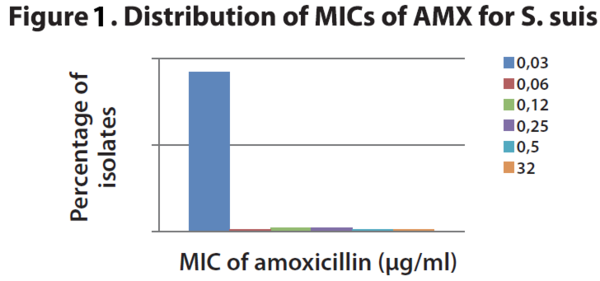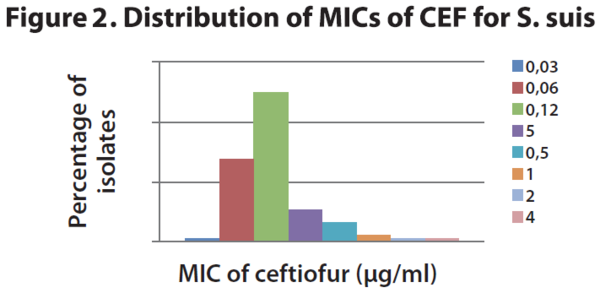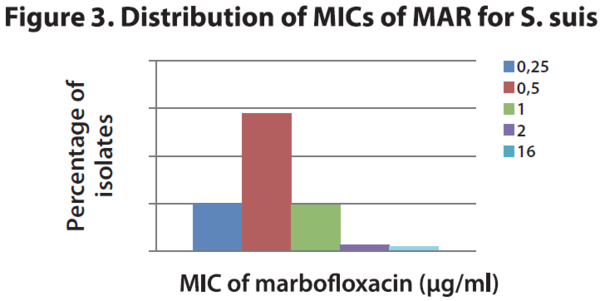.
-->Introduction
-->Results
-->Conclusion
.
DETERMINATION OF MINIMAL INHIBITION CONCENTRATIONS OF MAJOR ANTIBIOTICS FOR STREPTOCOCCUS SUIS
By Butty P., Krejci Roman - Ceva Animal Health, Libourne, France
.
Introduction
Streptococcus suis (S. suis) belongs to the most frequent bacterial pathogens in pigs raised in industrial farms. It is a primary pathogen inducing disease often associated with septicemia, meningitis, pneumonia, arthritis and endocarditis which can be often fatal. Sick animals should be treated as soon as possible with antibiotics. All pigs in a group should be treated when a single pig becomes clinically ill. Amoxicillin is the antibiotic of the first choice in the treatment and control of S. suis infections. The aim of this study was to compare the susceptibility of S. suis to amoxicillin (AMX) and other frequently used antibiotics in swine, namely ceftiofur (CEF) and marbofloxacin (MAR).
.
Materials and Methods
A total of 94 S. suis isolates were collected from clinically ill pigs from French (Labofarm) and German Veterinary Laboratories during the years 2009 and 2010. The strains were sub-cultured twice on 5% sheep blood Colombia agar (35°C for 16 to 18 hours) prior to MIC testing. MICs were determined for each antibiotic, using the micro-dilution method of the NCCLS2.
Briefly, 3 to 5 colonies of a 18 hours culture were removed, suspended in 5 ml of sterile 0.85% saline, and adjusted to yield approximately 5 x 105 CFU per ml. A 10μl aliquot of this suspension was then transferred to 10 ml of Mueller Hinton supplemented with yeast extracts; Complement C and 5% sheep blood. 50μl aliquot of this suspension was then dispensed into each well of a 96-well micro-dilution plate containing a serial pre-diluted antimicrobial agent in the same culture broth. Micro-dilution plates were then incubated at 35°C for 18 to 24 hours. The following quality control strains recommended by NCCLS were included with each batch of tested bacteria: S. aureus ATCC 29213; E. faecalis ATCC 29212; E. coli ATCC 25922 ; P. aeruginosa ATCC 27853 and S. pneumonia ATCC 49619.
.
Results
All strains of S. suis isolates were 100% sensitive to all three antibiotics. However differences in the MIC 90 were found between AMX, CEF and MAR (Table 1).
Table 1 MIC 50 and MIC 90 of AMX, CEF and MAR for S. suis
The distribution of particular MICs showed 92.2% strains susceptible to 0.03 μg/ml of AMX (Figure 1), 50% susceptible to 0.12 μg/ml of CEF (Figure 2) and 58% susceptible to 0.5 μg/ml of MAR (Figure 3).
CLSI Clinical breakpoint for AMX: < 0.25 ; > 8 μg/ml.
CLSI Clinical breakpoint for CEF : < 2 ; > 8 μg/ml.
CLSI Clinical breakpoint for MAR: No CLSI CBP
^ Top page
.
Conclusion
Amoxicillin was the most efficient antibiotic against S. suis isolates among the three major molecules examined in this study with 92% isolates being susceptible to the lowest concentration. This confirms that amoxicillin is still the optimal choice for the first line treatment and control of S. suis infections in pigs.
^ Top page
.
Bibliography
1 Gottschalk, AASV, 2002
2 NCCLS, M31-A3, Vol28 N°8-2008
.
(Source: Axis Issue 02 / Sept 2013 - Ceva Asia Pacific - Proceedings APVS 2013)
.
Related topics: axis Streptococcus suis mic swine antibiotic amoxicillin compare test

 Corporate Website
Corporate Website
 Africa
Africa
 Argentina
Argentina
 Asia
Asia
 Australia
Australia
 Belgium
Belgium
 Brazil
Brazil
 Bulgaria
Bulgaria
 Canada (EN)
Canada (EN)
 Chile
Chile
 China
China
 Colombia
Colombia
 Denmark
Denmark
 Egypt
Egypt
 France
France
 Germany
Germany
 Greece
Greece
 Hungary
Hungary
 Indonesia
Indonesia
 Italia
Italia
 India
India
 Japan
Japan
 Korea
Korea
 Malaysia
Malaysia
 Mexico
Mexico
 Middle East
Middle East
 Netherlands
Netherlands
 Peru
Peru
 Philippines
Philippines
 Poland
Poland
 Portugal
Portugal
 Romania
Romania
 Russia
Russia
 South Africa
South Africa
 Spain
Spain
 Sweden
Sweden
 Thailand
Thailand
 Tunisia
Tunisia
 Turkey
Turkey
 Ukraine
Ukraine
 United Kingdom
United Kingdom
 USA
USA
 Vietnam
Vietnam







